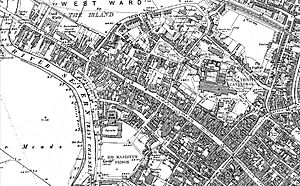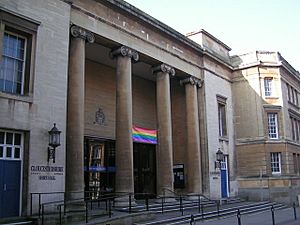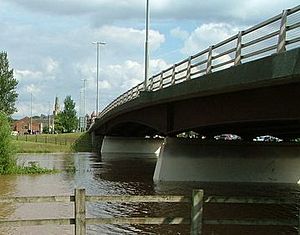Westgate, Gloucester facts for kids
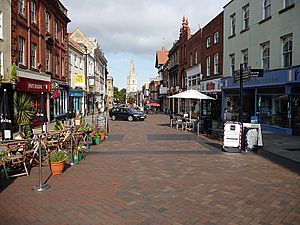
Welcome to the Westgate area of Gloucester! This historic part of the city is built around Westgate Street, which is one of Gloucester's four main streets. It's one of the oldest areas in the city, full of interesting stories and buildings. In 2011, about 6,687 people lived in the Westgate area.
Cool Buildings and Places
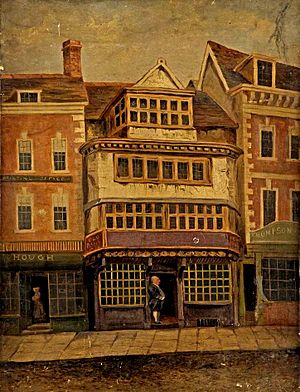
Westgate Street is home to many important and historic buildings.
St. Nicholas' Church
At one end of Westgate Street, you'll find St. Nicholas' Church. This church is no longer used for regular services, but it's a very old and important building. It's listed as a Grade I building, meaning it's of special historical interest. Right across from it is the Gloucester Folk Museum, which is a great place to learn about local history.
Gloucester Cathedral
Not far from Westgate Street is the amazing Gloucester Cathedral. You can get to the main entrance of the Cathedral grounds through College Green, which is just off Westgate Street.
Dick Whittington Tavern
Next to St. Nicholas' Church is the Dick Whittington Tavern. This building was originally a 15th-century house called St. Nicholas House. It was once owned by the Whittington family. You might know them from the famous story of Dick Whittington and his Cat! This old house was carefully fixed up in the 1980s.
St. Mary de Lode Church
Just outside the Cathedral area, in Archdeacon Street, is St. Mary de Lode Church. Some people believe this church was built on the spot of the very first Christian church in Britain. Next to it, you'll see a monument to Bishop John Hooper. He was an important religious leader who died there in 1555.
House of the Tailor of Gloucester
If you're a fan of classic children's books, you might know the House of the Tailor of Gloucester. This house, just off Westgate Street, was used by the famous author Beatrix Potter as the setting for her story of the same name.
Gloucester Shire Hall
The original part of Gloucester Shire Hall is also on Westgate Street. It opened in 1816 and was designed by a famous architect named Sir Robert Smirke.
Theatre Royal
On the north side of Westgate Street, there used to be the Theatre Royal. Many famous actors performed here, including Charles Dickens, Sir Henry Irving, and Ellen Terry. Today, a discount store stands where the theatre once was.
Local Pubs
Westgate Street has been home to many traditional pubs over the years. Some of them include:
- The Lower George Inn at 121 Westgate Street.
- The Fountain Inn at 53 Westgate Street.
- The Dick Whittington at 100 Westgate Street.
- The Sword Inn at 43/45 Westgate Street.
- Old Crown Inn at 81-83 Westgate Street.
- The Lamprey at 56 Westgate Street.
Famous People from Westgate
Some interesting people have lived in the Westgate area.
Jemmy Wood
Jemmy Wood, known as the Gloucester Miser, was a very wealthy and careful person. He ran his Gloucester Old Bank from an old timber building at 22 Westgate Street. This building was later replaced by newer ones.
Charles Wheatstone
Further down the street, you can find the former home of a young Charles Wheatstone. He was a brilliant scientist who helped create early telecommunications and cryptography (secret codes!). He also studied how music sounds.
Westgate Bridge
The Westgate Bridge crosses the River Severn and has a long history. It was once the longest bridge in England! It has been rebuilt many times over the years.
Early Bridges
The first medieval bridge had five large arches. In 1542, a man named Sir Thomas Bell and his wife Joan arranged for their property to be used to help pay for repairs to the Westgate Bridge and its pathway after they passed away.
In 1816, the old medieval bridge was replaced. The new bridge had a single arch and was designed by Sir Robert Smirke. He was the same architect who designed the famous British Museum and Gloucester Shire Hall.
Important Crossing Point
Until a new bridge called the Severn Crossing opened near Chepstow in 1966, the Westgate Bridge was the most southern place to cross the River Severn by road if you were traveling to or from Wales.
Modern Bridges
In the 1970s, two new, wider road bridges were built, one for traffic going in each direction. A separate bridge for walking and cycling was also added between them. These two road bridges were replaced again in the late 1990s and opened in the year 2000.
Today, there are special bicycle paths that use the central bridge. These paths connect nearby villages by going across Alney Island.


